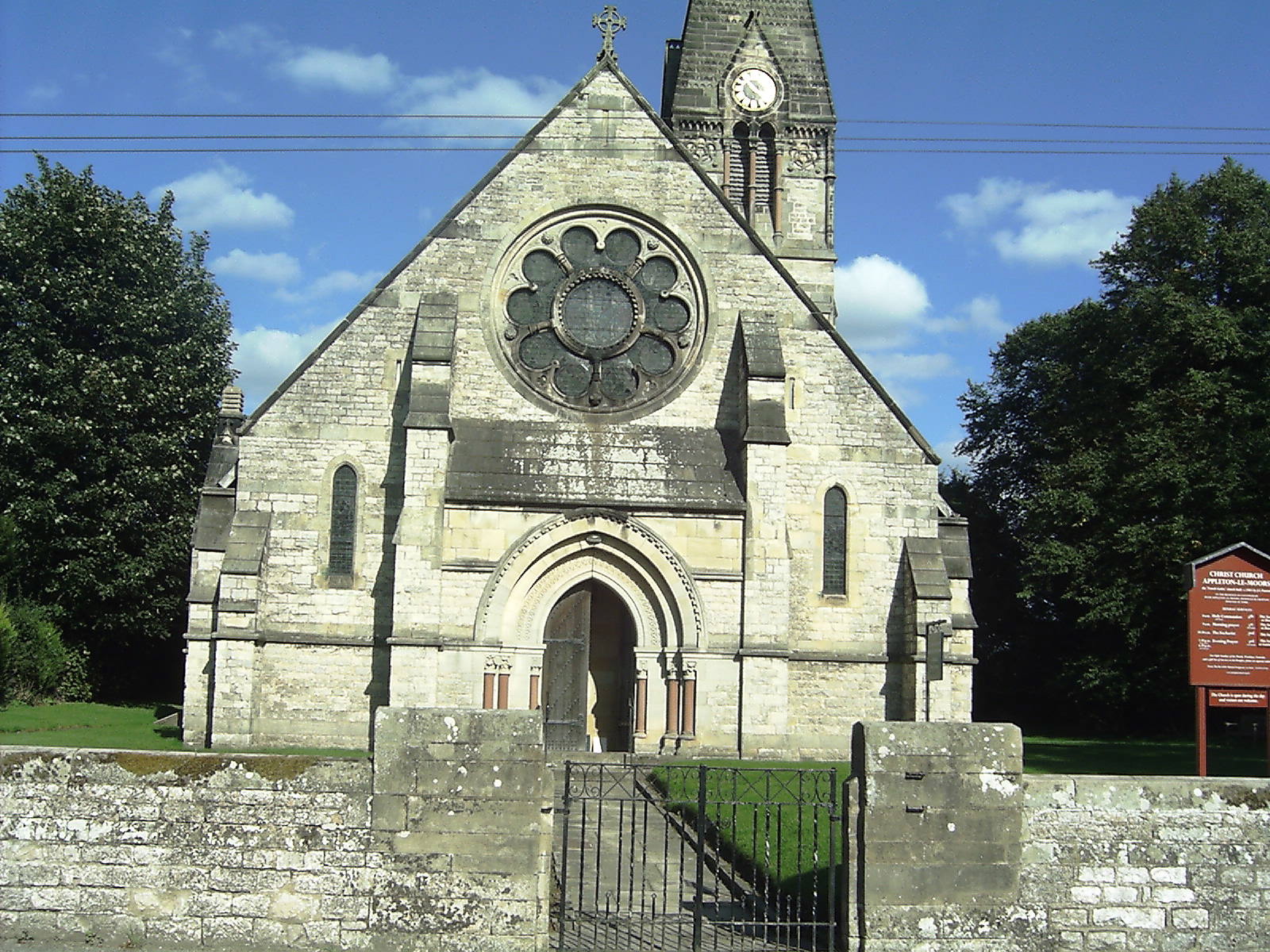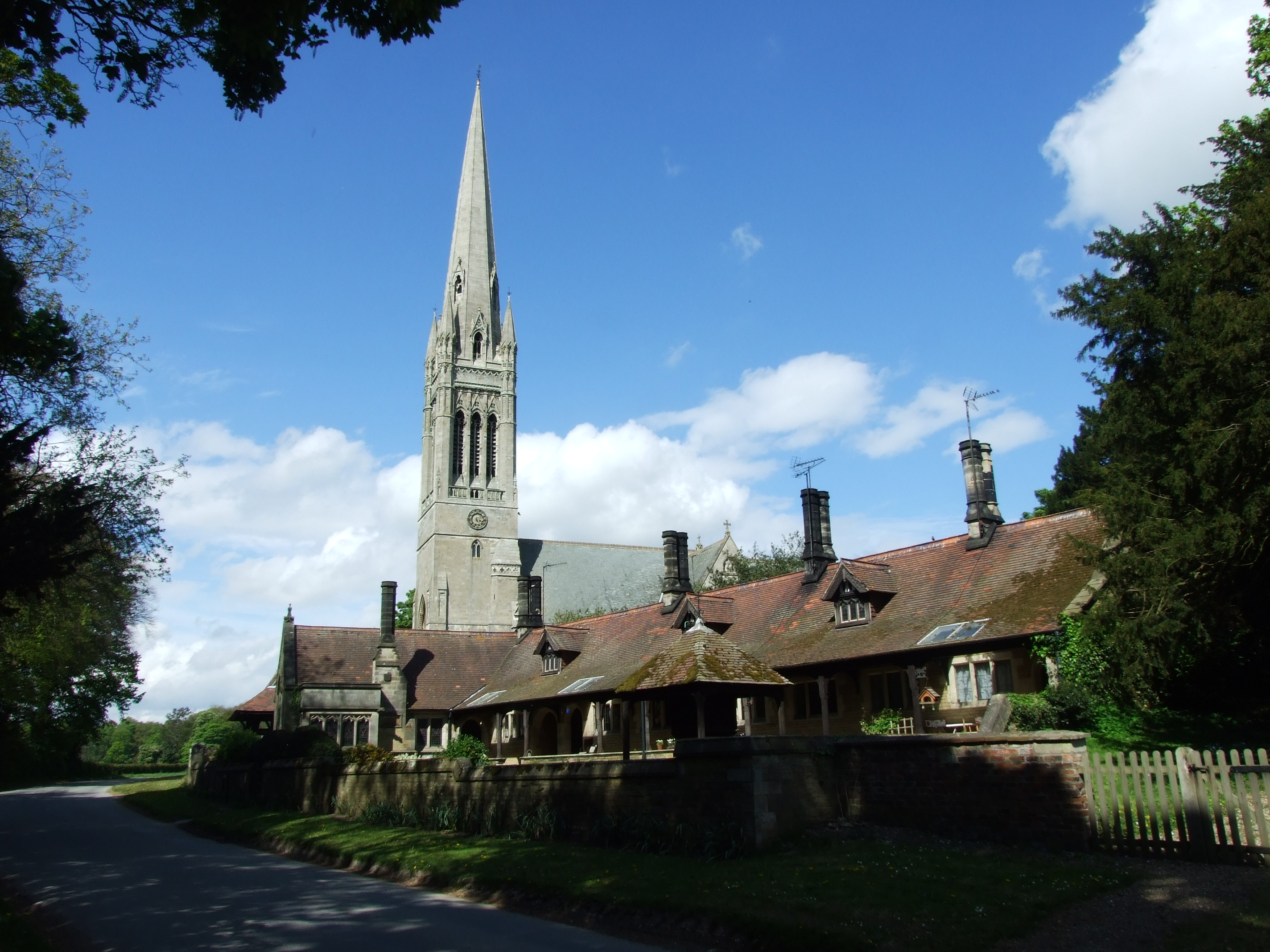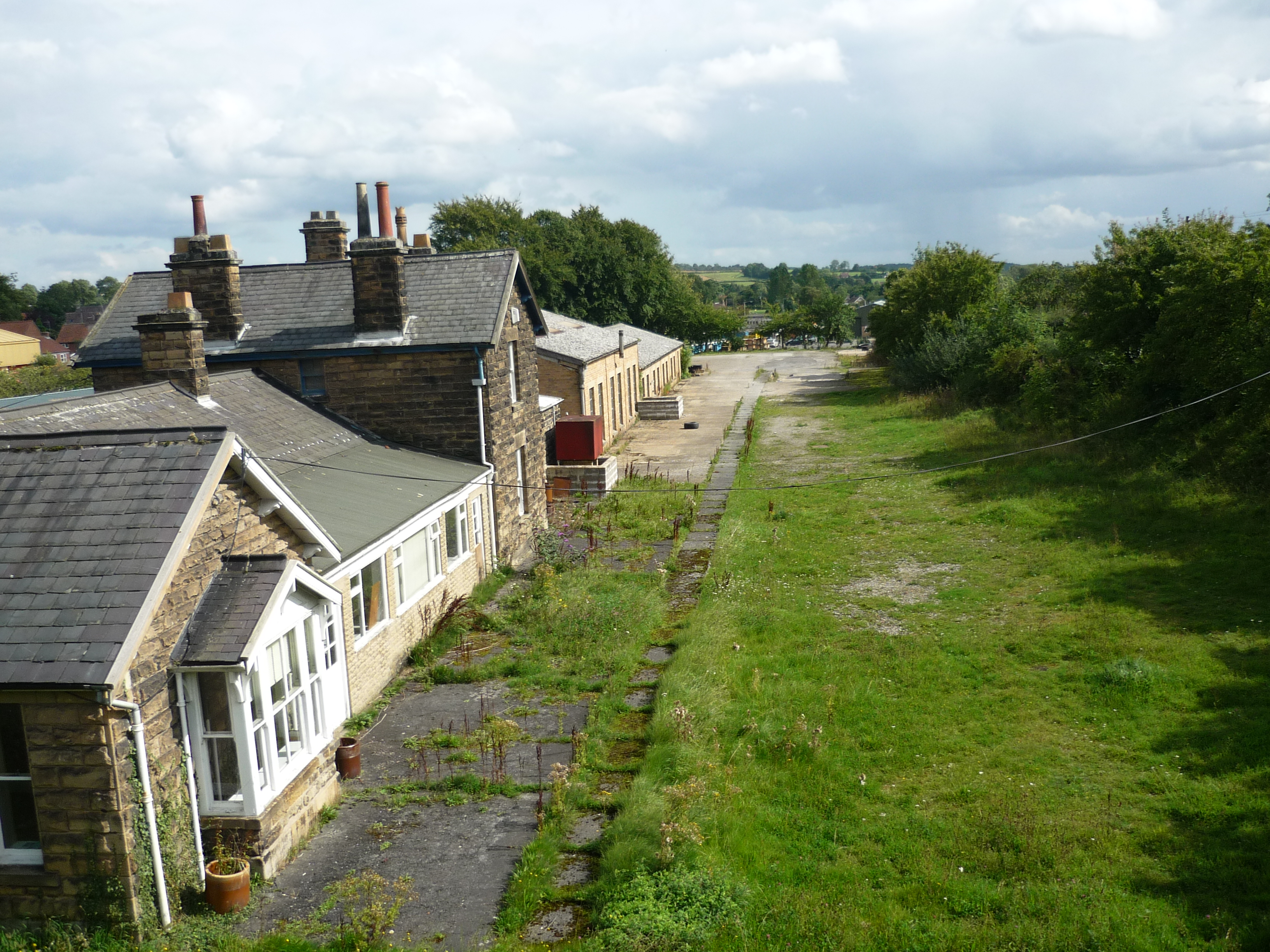|
Appleton-le-Moors
Appleton-le-Moors is a village and civil parish in the Ryedale district of North Yorkshire, England. According to the 2001 census it had a population of 183, reducing to 164 in the 2011 census. Historically part of the North Riding of Yorkshire, the village is in the North York Moors National Park, and is near to Pickering and Kirkbymoorside. This ancient village is recorded in the ''Domesday Book'' and retains its classic mediaeval layout. It is a site of archaeological interest, being a rich source of finds such as flint tools, Roman coins and a mediaeval oven. It is particularly noted for its exceptionally fine 19th century church which has earned the description "the little gem of moorland churches" and is Grade I listed. It was designed by the architect J.L. Pearson in French Gothic style with elaborate decoration, a tower surmounted with a spire, and a beautiful west-facing rose window of the 10-part (i.e. botanical) design similar to the White Rose of York, with sta ... [...More Info...] [...Related Items...] OR: [Wikipedia] [Google] [Baidu] |
Appleton-le-Moors Church Rose Window2
Appleton-le-Moors is a village and civil parish in the Ryedale district of North Yorkshire, England. According to the 2001 census it had a population of 183, reducing to 164 in the 2011 census. Historically part of the North Riding of Yorkshire, the village is in the North York Moors National Park, and is near to Pickering and Kirkbymoorside. This ancient village is recorded in the ''Domesday Book'' and retains its classic mediaeval layout. It is a site of archaeological interest, being a rich source of finds such as flint tools, Roman coins and a mediaeval oven. It is particularly noted for its exceptionally fine 19th century church which has earned the description "the little gem of moorland churches" and is Grade I listed. It was designed by the architect J.L. Pearson in French Gothic style with elaborate decoration, a tower surmounted with a spire, and a beautiful west-facing rose window of the 10-part (i.e. botanical) design similar to the White Rose of York, with sta ... [...More Info...] [...Related Items...] OR: [Wikipedia] [Google] [Baidu] |
John Loughborough Pearson
John Loughborough Pearson (5 July 1817 – 11 December 1897) was a British Gothic Revival architect renowned for his work on churches and cathedrals. Pearson revived and practised largely the art of vaulting, and acquired in it a proficiency unrivalled in his generation. He worked on at least 210 ecclesiastical buildings in England alone in a career spanning 54 years. Early life and education Pearson was born in Brussels on 5 July 1817. He was the son of William Pearson, etcher, of Durham, and was brought up there. At the age of fourteen, he was articled to Ignatius Bonomi, architect, of Durham, whose clergy clientele helped stimulate Pearson's long association with religious architecture, particularly of the Gothic style. He soon moved to London, where he became a pupil of Philip Hardwick (1792–1870), architect of the Euston Arch and Lincoln's Inn. Pearson lived in central London at 13 Mansfield Street (where a blue plaque commemorates him), and he was awarded the RIBA R ... [...More Info...] [...Related Items...] OR: [Wikipedia] [Google] [Baidu] |
North Yorkshire
North Yorkshire is the largest ceremonial counties of England, ceremonial county (lieutenancy area) in England, covering an area of . Around 40% of the county is covered by National parks of the United Kingdom, national parks, including most of the Yorkshire Dales and the North York Moors. It is one of four counties in England to hold the name Yorkshire; the three other counties are the East Riding of Yorkshire, South Yorkshire and West Yorkshire. North Yorkshire may also refer to a non-metropolitan county, which covers most of the ceremonial county's area () and population (a mid-2016 estimate by the Office for National Statistics, ONS of 602,300), and is administered by North Yorkshire County Council. The non-metropolitan county does not include four areas of the ceremonial county: the City of York, Middlesbrough, Redcar and Cleveland and the southern part of the Borough of Stockton-on-Tees, which are all administered by Unitary authorities of England, unitary authorities. ... [...More Info...] [...Related Items...] OR: [Wikipedia] [Google] [Baidu] |
Rose Window
Rose window is often used as a generic term applied to a circular window, but is especially used for those found in Gothic cathedrals and churches. The windows are divided into segments by stone mullions and tracery. The term ''rose window'' was not used before the 17th century and comes from the English flower name rose. The name "wheel window" is often applied to a window divided by simple spokes radiating from a central boss or opening, while the term "rose window" is reserved for those windows, sometimes of a highly complex design, which can be seen to bear similarity to a multi-petalled rose. Rose windows are also called "Catherine windows" after Saint Catherine of Alexandria, who was sentenced to be executed on a spiked breaking wheel. A circular window without tracery such as are found in many Italian churches, is referred to as an ocular window or oculus. Rose windows are particularly characteristic of Gothic architecture and may be seen in all the major Gothic Cathedr ... [...More Info...] [...Related Items...] OR: [Wikipedia] [Google] [Baidu] |
2011 Census For England And Wales
A census of the population of the United Kingdom is taken every ten years. The 2011 census was held in all countries of the UK on 27 March 2011. It was the first UK census which could be completed online via the Internet. The Office for National Statistics (ONS) is responsible for the census in England and Wales, the General Register Office for Scotland (GROS) is responsible for the census in Scotland, and the Northern Ireland Statistics and Research Agency (NISRA) is responsible for the census in Northern Ireland. The Office for National Statistics is the executive office of the UK Statistics Authority, a non-ministerial department formed in 2008 and which reports directly to Parliament. ONS is the UK Government's single largest statistical producer of independent statistics on the UK's economy and society, used to assist the planning and allocation of resources, policy-making and decision-making. ONS designs, manages and runs the census in England and Wales. In its capacity as t ... [...More Info...] [...Related Items...] OR: [Wikipedia] [Google] [Baidu] |
Kirkbymoorside
Kirkbymoorside () is a market town and civil parish in the Ryedale district in North Yorkshire, England. It is north of York, It is also midway between Pickering and Helmsley, on the edge of the North York Moors National Park. It had a population of 3,040 in the 2011 census. History Kirkbymoorside is noted as ''Chirchebi'' in the Domesday Book of 1086. It has served as a trading hub at least since 1254, when it became a market town. There are two ancient coaching inns extant, the ''Black Swan'' with its carved porch, and the cruck-framed ''George and Dragon'', which originated in the 13th century. The Georgian façades point to later periods of commercial prosperity on the coaching route between York and Scarborough. Some Ancient British, Viking and Anglo-Saxon remains have been found in the vicinity. The Norman baron Robert de Stuteville built a wooden moated castle on Vivers Hill. The estate passed to the Wake family in the 13th century, who brought prosperity to the town ... [...More Info...] [...Related Items...] OR: [Wikipedia] [Google] [Baidu] |
Lastingham
Lastingham is a village and civil parish which lies in the Ryedale district of North Yorkshire, England. It is on the southern fringe of the North York Moors, north-east of Kirkbymoorside, and to the east of Hutton-le-Hole. It was home to the early missionaries to the Angles, St. Cedd and his brother, St. Chad. At the 2001 census, the parish had a population of 96, increasing to 233 (including Spaunton) at the 2011 Census. It is in the historic North Riding of Yorkshire. History There is reason to believe that the original name for Lastingham was Læstingau. Læstingau first appears in history when King Ethelwald of Deira (651-c.655) founded a monastery for his own burial. Bede attributes the initiative to Ethelwald's chaplain Caelin, brother of Cedd, Chad and Cynibil. Bede records that Cedd and Cynibil consecrated the site, and that Cynibil built it of wood. Cedd ruled the monastery as the first abbot until his death, combining this position with that of missionary bi ... [...More Info...] [...Related Items...] OR: [Wikipedia] [Google] [Baidu] |
White Rose Of York
The White Rose of York (Latinised as ''rosa alba'', blazoned as ''a rose argent'') is a white heraldic rose which was adopted in the 14th century as a heraldic badge of the royal House of York. In modern times it is used more broadly as a symbol of the county of Yorkshire. History The symbolism of the white rose has religious connotations as (like the white lily) it represents the purity of the Virgin Mary, one of whose many titles in the Roman Catholic faith is the ''Mystical Rose of Heaven''. In Christian liturgical iconography white is the symbol of light, typifying innocence, purity, joy and glory. The white rose was first adopted as a heraldic badge by Edmund of Langley, 1st Duke of York (1341–1402), the fourth surviving son of King Edward III of England. One of his elder brothers, John of Gaunt, 1st Duke of Lancaster (1340–1399) adopted a red rose as a heraldic badge, the red rose of Lancaster. Their respective descendants fought for control of the throne of En ... [...More Info...] [...Related Items...] OR: [Wikipedia] [Google] [Baidu] |
Domesday Book
Domesday Book () – the Middle English spelling of "Doomsday Book" – is a manuscript record of the "Great Survey" of much of England and parts of Wales completed in 1086 by order of King William I, known as William the Conqueror. The manuscript was originally known by the Latin name ''Liber de Wintonia'', meaning "Book of Winchester", where it was originally kept in the royal treasury. The '' Anglo-Saxon Chronicle'' states that in 1085 the king sent his agents to survey every shire in England, to list his holdings and dues owed to him. Written in Medieval Latin, it was highly abbreviated and included some vernacular native terms without Latin equivalents. The survey's main purpose was to record the annual value of every piece of landed property to its lord, and the resources in land, manpower, and livestock from which the value derived. The name "Domesday Book" came into use in the 12th century. Richard FitzNeal wrote in the ''Dialogus de Scaccario'' ( 1179) that the book ... [...More Info...] [...Related Items...] OR: [Wikipedia] [Google] [Baidu] |
Christ Church Appleton-le-Moors
Jesus, likely from he, יֵשׁוּעַ, translit=Yēšūaʿ, label=Hebrew/Aramaic ( AD 30 or 33), also referred to as Jesus Christ or Jesus of Nazareth (among other names and titles), was a first-century Jewish preacher and religious leader; he is the central figure of Christianity, the world's largest religion. Most Christians believe he is the incarnation of God the Son and the awaited Messiah (the Christ) prophesied in the Hebrew Bible. Virtually all modern scholars of antiquity agree that Jesus existed historically. Research into the historical Jesus has yielded some uncertainty on the historical reliability of the Gospels and on how closely the Jesus portrayed in the New Testament reflects the historical Jesus, as the only detailed records of Jesus' life are contained in the Gospels. Jesus was a Galilean Jew who was circumcised, was baptized by John the Baptist, began his own ministry and was often referred to as "rabbi". Jesus debated with fellow Jews on how ... [...More Info...] [...Related Items...] OR: [Wikipedia] [Google] [Baidu] |
Pickering, North Yorkshire
Pickering is a market town and civil parishes in England, civil parish in the Ryedale district in North Yorkshire, England, on the border of the North York Moors National Park. Historic counties of England, Historically part of the North Riding of Yorkshire, it is at the foot of the moors, overlooking the Vale of Pickering to the south. Pickering Parish Church, with its medieval wall paintings, Pickering Castle, the North Yorkshire Moors Railway and Beck Isle Museum have made Pickering popular with visitors. Nearby places include Malton, North Yorkshire, Malton, Norton-on-Derwent and Scarborough, North Yorkshire, Scarborough. History Positioned on the shores of a glacial lake at the end of the Last Glacial Period, last ice age, Pickering was in an ideal place for early settlers to benefit from the multiple natural resources of the moorlands to the north, the wetlands to the south, running water in the Costa Beck, beck and the forests all around. It had wood, stone, wildfowl, g ... [...More Info...] [...Related Items...] OR: [Wikipedia] [Google] [Baidu] |
Ryedale
Ryedale is a non-metropolitan district in North Yorkshire, England. It is in the Vale of Pickering, a low-lying flat area of land drained by the River Derwent. The Vale's landscape is rural with scattered villages and towns. It has been inhabited continuously from the Mesolithic period. The economy is largely agricultural with light industry and tourism playing an increasing role. Towns include Helmsley, Kirkbymoorside, Malton, Norton-on-Derwent, and Pickering. Part of Ryedale lies within the North York Moors National Park. The A64 passes through Ryedale and villages such as Rillington. In the 2011 Census, the population of this primarily rural area of 150,659 hectares, the largest district in North Yorkshire, was 51,700. Derivation of name The name refers to the River Rye and was previously used for the Ryedale wapentake of Yorkshire, which covered roughly the same area. The current district was formed on 1 April 1974, under the Local Government Act 1972, and was a merg ... [...More Info...] [...Related Items...] OR: [Wikipedia] [Google] [Baidu] |







